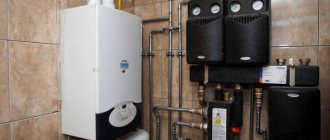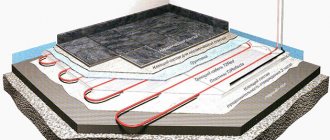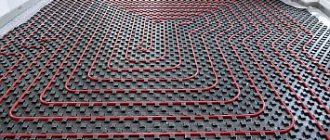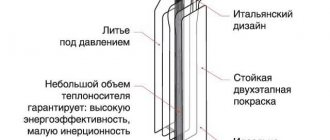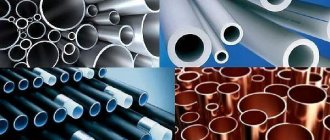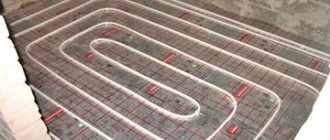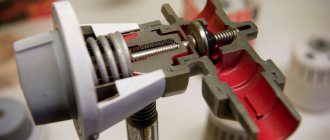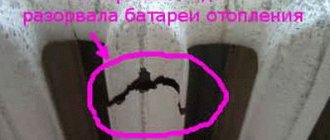Imagine how you get out of bed in your country house in the morning, step on the soft carpet in the direction of the kitchen in order to make coffee and start a new day, and then at one moment the warm pile ends and your foot finds itself on an ice tile. Not the most pleasant start to the day, is it?
This can be avoided by considering the installation of heated floors at the construction stage. Then every day, in at least one room of the house, your feet will not freeze.
Pros and cons of water heated floors
The water heated floor got its name due to the fact that it has some similarity with the classic heating system for multi-storey buildings - radiator. In the case of gender, everything is, on the one hand, simpler, on the other – more complicated.
The pipes carrying hot water are mounted on a screed, filled with concrete, and a floor covering is laid on top. Such manipulations are difficult to carry out independently, unless, of course, you have the appropriate experience and specialization, but it is worth admitting that such masters do not live in every apartment. In addition, there are certain problems with installing such a heating system in a city apartment - you need to coordinate this with the management company, but in private houses it is best to decide on using a heated floor at the foundation pit stage, or even better at the time of design. In the latter case, our company can manufacture plates with special recesses for wires and thermostats.
pros
Heated floors have a large number of advantages:
- The most economical home heating system. Due to the fact that the coolant itself has a relatively low temperature (up to 50 degrees), in rooms with high ceilings, the cost of heating the room is reduced by exactly half.
- Even heat distribution. Due to the fact that the heating comes from the floor, an optimal distribution is achieved - about 23 degrees at the level of the legs and 18 at the head.
- Operational safety. All heating elements are securely hidden under the flooring, which allows you to safely leave small children in the room and not worry about them getting burned.
- Aesthetics. The absence of visible heating elements allows you to create modern interiors without being tied to how best to hide, for example, radiators or convectors.
- Utility. In a house with heated floors it is much more difficult to catch a cold or feel uncomfortable. This is especially true for families with small children, who can simply be left on the floor without warm onesies or woolen socks.
Minuses
In addition to a large number of advantages, heated floors also have their disadvantages:
- As mentioned above, one of the main disadvantages of a water floor is that its installation must be carried out by professionals. And also it cannot be installed with heating from a gas boiler, because the floor will be too hot and all its advantages are offset by this one minus.
- If pipes are laid incorrectly, a leak may occur that will be difficult to repair. This is due to the fact that the pipes are filled with concrete mixture at one of the installation stages and, accordingly, if something happens, the entire structure has to be dismantled.
- Experts do not recommend using heated floors as the only heating system in the house. Ideally, it should be duplicated by additional heaters. Here you can add such a minus as the impossibility of regulating the temperature; if the floor becomes hot, then you can only turn it off and wait for it to cool down.
- Among other things, there are always places where it is impossible to install a water floor, and accordingly, it will still be necessary to install, for example, convectors there.
- Heavy furniture cannot be installed on top of such a heating system, that is, under a cabinet - the floor will not generate heat.
Thermal dynamics
This indicator characterizes the rate at which the heating element gains temperature and transfers it to the serviced space:
- Vodyanoy . It is distinguished by the greatest inertia, which is due to the total heat capacity of the liquid in the system and the screed. This somewhat reduces the comfort of use (warm-up time increases significantly), but allows you to heat the coolant not constantly, but periodically, at fairly large intervals.
- Cable . It has much greater inertia, since the air in the room will begin to warm up only after the screed has warmed up. With the correct choice of subfloor material (its heat capacity), it is possible to ensure that the temperature is maintained for a long time after the heater is turned off.
- Rod , depending on the installation method, shows results similar to film (when installed under a final coating) or cable (when installed in a screed).
- Film electric - quickly warms up and warms the air in the room, since it only works with a fine coating. It also cools down quickly.
Expert opinion
Grebnev Vadim Savelievich
Heating system installer
For electric heated floors of all types, it is also possible to use power and temperature control by periodically turning on the heating element. However, transient processes in this case reduce the service life and reliability of the system. Therefore, manufacturers recommend using not a pulse mode for regulation, but power regulators that change the supply voltage at the system input.
Pros and cons of electric heated floors
Electric heated floors, unlike water ones, have several implementation options:
- cable,
- film,
- mats.
And accordingly, each of them has its own advantages over the others, as well as its own disadvantages.
Cable floor
This type of electric heating system is considered one of the most popular and quite budget-friendly. It consists of special, heat-resistant cables that heat up when exposed to a small current and transfer heat to the floor covering. Like water floors, this type is laid in a screed, which can create some difficulties during turnkey repairs already completed.
The main disadvantage is that if the cable is damaged during operation, then the entire section will have to be replaced; also, few people will like the option that the floors can be used only two weeks after installation.
Heating mats
Formally, these are the same heating cables, simply laid out in a “snake” at the factory and sealed in a special fabric. As a result, their installation is simplified several times. There is no need to make a screed; the mats are placed on a special glue. The only thing is that additional grooves are made on the existing concrete field for better adhesion of the glue and the canvas.
And this type has the same drawback as the previous one - if the sensor fails or a small area is damaged, you will have to re-cover the entire floor or forget about what it’s like to feel warm on your feet.
Infrared film
Of all the underfloor heating options, infrared is one of the most effective ways to heat a room. When using such a film, it seems that the temperature in the room is higher than the thermometer shows. And many will also appreciate the fact that such a system can be installed not only in the floor, but also in the walls, and even in the ceiling, which seriously expands the horizons of creating a warm and cozy home.
It is also difficult to find any disadvantages - this system is installed in one day, you can use all its heating resources immediately after installation, if one of the sections fails, you do not need to change the entire section, but simply replace the broken one and start enjoying the warmth again.
Finishing
The work at this stage is no different from conventional flooring installation. Restrictions are imposed on the surface temperature, and not on the type of decorative finish.
IMPORTANT: absolutely any floor covering can be laid on water-heated floors. But some of them can reduce the energy efficiency of underfloor heating. The type of substrate is also taken into account when laying laminate flooring. For such a base, a thin, noise-absorbing, rather than heat-insulating, substrate is needed.
General disadvantages and advantages of electric heated floors
Speaking about the advantages of electric heated floors over water ones, one cannot fail to mention:
- Fast and comfortable heating of the room.
- Safety in terms of operation. Such a system will not leak and will not spoil the repairs on the lower floors.
- Relatively easy to install. As mentioned above, some of the options don't even require you to be on the floor.
But, like everyone else, the electric floor also has its disadvantages:
- High electricity consumption for heating. Although there is a solution to reduce costs and level out this disadvantage - heated floors are only installed in the kitchen, bathroom and children's room - all the same, the blow to the wallet can be quite significant.
- Compared to a fairly budget water floor, there are high installation costs and the heating elements themselves.
Review of popular manufacturers
The final cost of 1 square meter of warm water floors also depends on the choice of components produced by different brands. At the moment, on the domestic market you can purchase a Rehau warm water floor, produced in Germany. The German brand guarantees high quality products and excellent consumer characteristics of the system. The affordable price of a Rehau water-heated floor allows you to save money already at the first stage of a home heating project.
Among other advantages that a Rehau warm water floor has, it is worth highlighting the following qualities:
- availability of a warranty from the manufacturer;
- environmental friendliness;
- quick installation;
- efficiency;
- Possibility of use in heating circuits of varying complexity.
Manufacturers from other countries also operate on the market, these are:
- German brand Kermi;
- brand from Finland Uponor;
- German company Oventrop;
- Turkish manufacturer Unipex;
- Ecoplastic brand from Poland, etc.
The choice of manufacturers is quite large and the consumer may not be limited to foreign brands, because in addition to those listed, companies from the Russian Federation and neighboring countries sell their products on the market at more affordable prices.
Which is better?
When choosing a heated floor for your home made from SIP panels, you should focus on your financial capabilities, and also, of course, trust the installation only to professionals. As mentioned above, improper installation of, for example, a water heating system can entail even greater costs and a large number of troubles.
On our website you can look at projects of SIP houses and use their layouts to immediately decide where exactly the floor will warm your feet.
Which is more reliable?
There are certain advantages and disadvantages for each type of underfloor heating. Electrical cable - quality products from some domestic and European manufacturers have a lifetime warranty. Even a relatively inexpensive wire will work for 20 years without problems. Most often, the temperature sensor or power regulator fails.
Water circuit - the pipe itself has a long service life, but the fittings fail within 10-15 years. The comparative characteristics of water and electric floors in this case are not in favor of the former. Even professional installation teams cannot always accurately determine the location of the leak, so repairs may require dismantling the screed.
